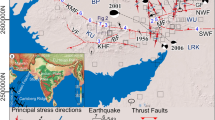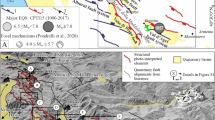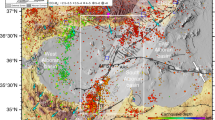Abstract
AN earthquake fault is a ground fracture formed in association with a shallow earthquake, usually by reactivation of a pre-existing geological fault. It can provide information about both the mechanism of seismic energy release during an earthquake and the accompanying regional strains. Until now only two such faults which have been adequately documented are known in Iran. These are associated with the Buyin Zara (1962) and the Dasht-e Bayaz (1968) earthquakes1–3. The Torud (1953) and the Ashkhabad (1948) earthquake4,5 (the latter in the USSR, just north of the Iranian frontier), were probably also accompanied by faulting, but complete documentation is lacking. Here, we describe three additional earthquake faults found during recent seismotectonic field studies in Iran. The earthquakes involved were at Selakhor (1909), Baghan-Germab (1929) and Salmas (1930). Figure 1 shows the location of the three faults and of the other known and probable faults already mentioned.
This is a preview of subscription content, access via your institution
Access options
Subscribe to this journal
Receive 51 print issues and online access
$199.00 per year
only $3.90 per issue
Buy this article
- Purchase on Springer Link
- Instant access to full article PDF
Prices may be subject to local taxes which are calculated during checkout
Similar content being viewed by others
References
Ambraseys, N. N., Bull. seism. Soc. Am., 53, 705 (1963).
Ambraseys, N. N., and Tchalenko, J. S., Bull. seism. Soc. Am., 59, 1751 (1969).
Tchalenko, J. S., and Ambraseys, N. N., Bull. geol. Soc. Am., 81, 41 (1970).
Abdalian, S., La Nature, 81, 314 (1953).
Gorshkov, G. P., Geologia SSSR, 23, 519 (1957).
Gutenberg, B., and Richter, C. F., Seismicity of the Earth and related Phenomena, (Princeton University Press, Princeton, 1954).
Shtelling, E., C. r. Commission sism. Permanente, 3, 32 (1910).
Braud, J., and Ricou, L. E., C. r. hebd. Séanc. Sci. Paris, 272, 203 (1971).
Gansser, A., Fourth Petrol. Congr. (Rome), Sect. 1, 279 (1955).
Stöcklin, J., Bull. Am. Ass. Petrol. Geol., 52, 1229 (1968).
Falcon, N. L., Advmnt Sci. Lond., 24, 31 (1967).
Gorshkov, G. P., Trudy seism. Inst., 95, 7 (1941).
Rastsvetaev, L. M., in Noveishie Tektonicheskie Dvijenia i Strukturi Alpiskovo Geosinklinalnovo Poiasa Yugo-zapadnoi Evrazii, (Akad. Nauk Azerb. SSSR, Baku) (1970).
Kopp, M. L., Rastsvetaev, L. M., and Trifonov, V. G., Izv. Akad. Nauk. Ser. Geol., 7, 59 (1964).
Tchalenko, J. S., Berberian, M., and Behzadi, H., Tectonophysics, 19, 333 (1973).
Richter, C. F., Elementary Seismology, (Freeman, San Francisco, 1958).
Bonilla, M. G., in Earthquake Engineering, (edit. by Wiegel, R. L.), (Prentice-Hall, New Jersey, 1970).
McKenzie, D., Geophys. J. R. astr. Soc., 30, 109 (1972).
Author information
Authors and Affiliations
Rights and permissions
About this article
Cite this article
TCHALENKO, J., BRAUD, J. & BERBERIAN, M. Discovery of three earthquake faults in Iran. Nature 248, 661–663 (1974). https://doi.org/10.1038/248661a0
Received:
Revised:
Issue Date:
DOI: https://doi.org/10.1038/248661a0
This article is cited by
-
Seismic loss assessment of residential buildings in Karaj, Iran, by considering near-source effects using stochastic finite-fault approach
Natural Hazards (2023)
-
Role of fault structural heterogeneity in nucleation location of the Mw ≥ 7 Earthquakes in Iran
Environmental Earth Sciences (2021)
-
Short-term seismicity patterns along the most active faults in Iran
Journal of Iberian Geology (2021)
-
Feasibility study of earthquake early warning in Tehran, Iran
Journal of Seismology (2021)
-
How much the Iranian government spent on disasters in the last 100 years? A critical policy analysis
Cost Effectiveness and Resource Allocation (2020)
Comments
By submitting a comment you agree to abide by our Terms and Community Guidelines. If you find something abusive or that does not comply with our terms or guidelines please flag it as inappropriate.



